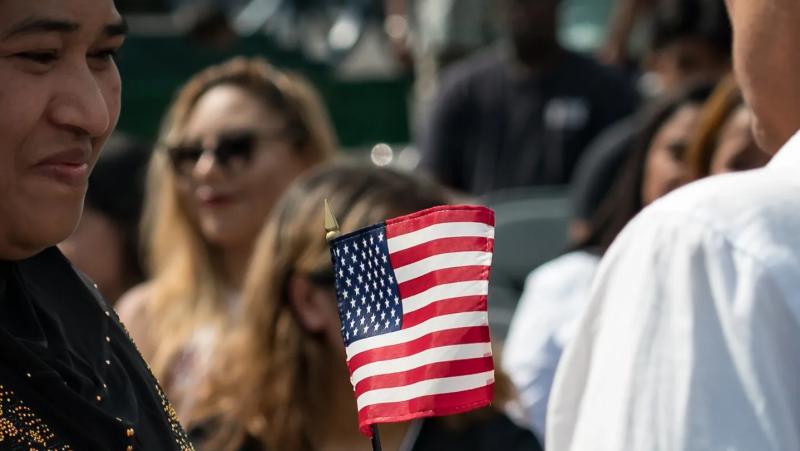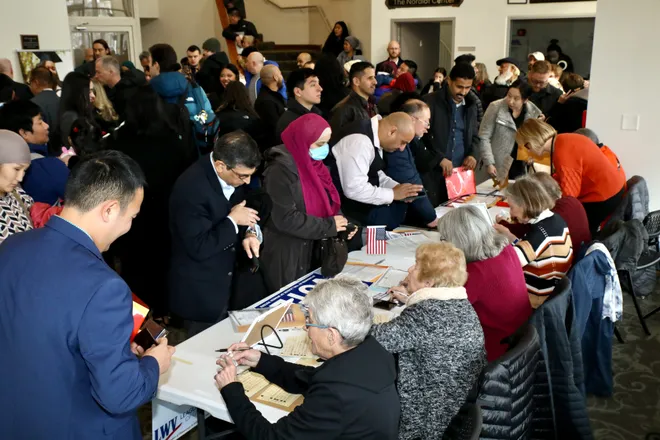The cost of U.S. citizenship is about to rise

The cost of applying for U.S. citizenship is about to rise.
More than 9 million legal permanent residents in the United States are eligible to apply for U.S. citizenship but haven’t done so yet, according to the Office of Homeland Security Statistics. On April 1, the cost of the application to naturalize is climbing as much as 19%.
The price of getting a "green card" – the first step to citizenship – will jump, too.
The changes are a fraction of the fee increases sought by the Trump administration before a federal judge scrapped them. Still, immigration attorneys say immigration costs almost always trend higher, so those who want to naturalize for less should consider submitting an application before April 1.
Here’s what to know about the fee increases.
More:Can the US handle more immigration? History and the Census suggest the answer is yes.
How much does U.S. citizenship cost?
The costs vary. The naturalization application form, called an N-400, currently costs $640 when filing a paper application or $725 including the fingerprint fee, called "biometrics." On April 1, the cost of both jumps to $760. A fee table published in the Federal Register shows the new price of immigration benefits.
The price hike is far less than what the Trump administration tried to impose.
In 2020, USCIS bumped the fee for naturalization more than 80% to $1,170 and ended the fee waiver for vulnerable individuals, including asylum-seekers.
Immigrant rights groups sued and a federal judge prevented the new rules from taking effect, saying USCIS violated the law by failing to provide adequate notice and an opportunity for public comment.
For those seeking an adjustment of status, from a tourist visa to legal permanent residency, the price hike is significant, said Xiao Wang, chief executive of Boundless Immigration, which provides immigration services.
That "green card" packet requires at least four different forms for most applicants, and certain fees are waived when submitted together under the current guidelines. After April 1, the price of pursuing legal permanent residency will jump from $1,760 to $3,005, he said.
The new guidelines also expand the universe of people eligible for a discount.
Those who earn below 400% of the federal poverty guideline can access the reduced rate instead of only those who earned below 200% of the poverty guideline. But the discounted rate is going up, too: from $320 to $380.

The cost increase may be less than USCIS' previous attempt to boost fees, but it can still be a burden for families when more than one family member wants to naturalize and each individual has to pay a separate application fee.
"You have a multiplier, and it adds up quite a bit," said Hector Quiroga, an immigration attorney who represents farmworkers in Spokane, Washington, and Las Vegas. "There are many people who simply can’t afford it."
Also, applying for U.S. citizenship doesn’t guarantee that USCIS will approve the application, and fees are nonrefundable.
Will USCIS wait times and customer service improve?
USCIS is adjusting fees to a variety of applications, including raising some and lowering others, "to fully recover costs and maintain adequate service," according to the announcement in the Federal Register. Fees haven't gone up since 2016.
Wang said it would make more sense to tie fee increases to inflation, "so that we’re not in a world where there is significant time that passes and then there is a big jump."
USCIS is primarily funded by the fees charged to applicants and petitioners for immigration benefits and doesn't receive regular congressional appropriations. At the same time, the agency has faced a surging workload amid high levels of migration to the U.S. The agency received nearly 11 million applications for benefits in fiscal 2023 – a record.
The fees also help cover the costs of services that are provided free of charge to refugees, asylum-seekers and certain other vulnerable classes of immigrants, DHS said.
The American Immigration Lawyers Association advocated that the fee increases should be used to help improve the agency’s lengthy processing times and opaque customer service.
"We understand there is a need to increase the fees," said Shev Dalal-Dheini, the association's senior director for government relations. "What we want to see in response is a reduction in the processing times, the backlog and more efficiency from the agency in adjudicating cases."
How long does it take to become a U.S. citizen?
USCIS said it delivered a citizenship oath of allegiance to more than 878,500 people in fiscal 2023 and reduced the average wait time for naturalization from 10.5 months to six months.
But first, it can take months or years to obtain the necessary prerequisite: legal permanent residency, sometimes called a green card. Legal permanent residents become eligible to apply for citizenship after three to five years, depending on who is applying.
Wait times for naturalization applications also vary across the country according to USCIS’ online case processing tool, which states the average wait time for 80% of applicants for each USCIS office. It ranges from five months in Cleveland, Ohio; to seven months in Boston, Los Angeles and Houston; to eight months in Minneapolis and Kansas City, Missouri.
There are additional requirements beyond the N-400 application. Applicants must prove the length of their residency; show they haven’t lived outside the United States for a prolonged period; and demonstrate what USCIS calls “good moral character.”
That means “you did not have certain types of crimes – such as murder, illegal gambling, or intentionally lying to the U.S. government in order to gain immigration benefits – on your record at any time before filing, and you did not lie during your naturalization interview,” according to Boundless Immigration, an agency that offers immigration services.
Some applicants must also pass an English language test and a civics exam.
If I apply for U.S. citizenship, how soon can I vote?
For applicants lucky enough to see their cases adjudicated in fewer than six months, there may still be time to register to vote in the 2024 presidential election, said Dalal-Dheini.

Voter registration rules vary state by state. Nineteen states and Washington, D.C., allow same-day voter registration, according to the National Conference of Legislatures.
Many immigrants weigh a variety of factors before applying for U.S. citizenship, including whether their home country requires them to renounce citizenship or whether acquiring dual citizenship results in tax or other financial penalties back home.
Still, Quiroga said he recommends clients "advance their legal position as much as possible."
At a time of heightened rhetoric around immigration – when politicians are questioning the foundational norms, including birthright citizenship – the rules of the game could change at any time, he said.
Dalal-Dheini echoed the advice.
"We have seen the rise in anti-immigrant rhetoric," she said. "To ensure that an individual’s status is secure, the best remedy is to become a citizen."
Lauren Villagran can be reached at lvillagran@usatoday.com, on X @laurenvillagran and on Instagram @fronteravillagran.
Disclaimer: The copyright of this article belongs to the original author. Reposting this article is solely for the purpose of information dissemination and does not constitute any investment advice. If there is any infringement, please contact us immediately. We will make corrections or deletions as necessary. Thank you.





